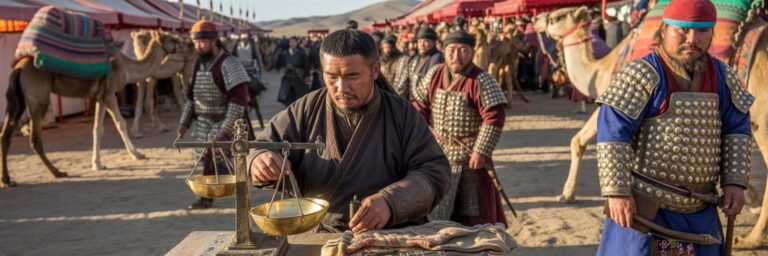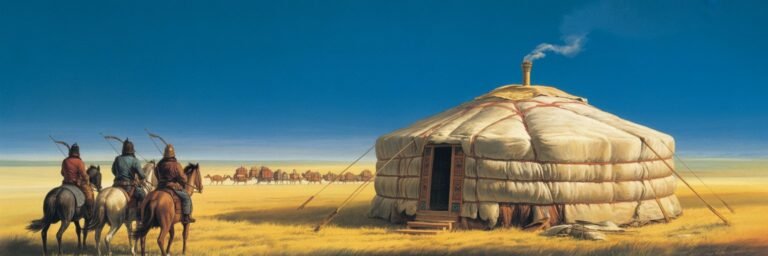INTRODUCTION
If one were to embark on a journey back in time, tracing their steps through the wide expanse of world history, the Mongols would stand as a fierce and powerful symbol of a nomadic civilization that caused a ripple effect globally, with their military conquests and societal strides, from the high steppes of Mongolia to the far reaches of Eurasia. Perhaps less known, however, is their profound influence on the realms of art and architecture—elements that paint a vivid picture of their cultural vitality and innovation. This exploration delves into the artistic ventures and architectural prowess of the Mongol Empire, revealing an empire that was as sophisticated and creative as it was fierce and fearsome.
HISTORICAL BACKGROUND
Genghis Khan’s establishment of the Mongol Empire in the 12th century wasn’t merely the beginning of a military powerhouse—it marked the foundation of an empire deeply invested in facets of art and architecture. Influenced by the numerous cultures they encountered during their extensive conquests, the Mongols integrated these elements seamlessly into their own artistry, creating a harmonious blend of styles, techniques, and beliefs.
The Mongol Empire’s influence stretched from their homeland in Mongolia, across the heart of Eurasia to as far as Eastern Europe, the Middle East, and China. This vast network provided an avenue for cultural exchange and artistic evolution, taking ideas and techniques from the Persians, the Chinese, the Islamic world, and the Byzantines.
THEORIES AND INTERPRETATIONS
For centuries, historians and scholars have debated and interpreted the impact of Mongol art and architecture. Mainstream theories propose that Mongol artistry was primarily a confluence of the diverse cultures they encountered—an amalgam of Chinese, Persian, Uighur, and Islamic influences. Many scholars highlight the symbolic nature of Mongol art, noting its reflection of the delicate balance between man and nature, inherent in their nomadic lifestyle.
Contrasting this dominant interpretation is the less popular theory that Mongol artistry retained its distinctiveness, despite the foreign cultural influences. However, this stance is also backed by concrete evidence from illuminated manuscripts and other artifacts that demonstrate a unique Mongol style.
MYSTERIES AND CONTROVERSIES
Mysteries and controversies have always surrounded the Mongol Empire, especially concerning their art and architecture. The Mongols left behind few structures and their artistic creations were typically portable or perishable—suiting their nomadic way of life. Their magnificent capital, Karakorum, conceived under the vision of Genghis Khan’s son, Ögedei, was marvelously constructed, featuring cosmopolitan influences and a sophisticated plan, but its ruins remain a historical enigma.
The meager remnants of physical structures and the limited artistic corpus have led to a paradoxical view of Mongol culture—portrayed often as violent conquerors with minimal artistic or architectural legacy. This narrative, however, fails to capture the cultural repurposing and integration practiced by the Mongols, as they inherited and reinterpreted the artistic techniques and aesthetics of those they ruled over.
SYMBOLISM AND CULTURAL SIGNIFICANCE
Mongolian art is brimming with symbolisms, often portraying the harmony between man and nature, a reflection of their nomadic lifestyle. Eagle hunting, equine warfare, and animal art are all recurring themes, indicating the significance of nature and the outdoors in Mongol culture.
The Mongol Empire had a profound impact on the dissemination and development of artistic motifs across its span. In architecture, the Persian Ilkhanate, one of the Mongol khanates, is widely recognized for its introduction of Mongol elements into Islamic architecture, as seen in the construction of advanced buildings in Iran’s capital, Tabriz.
MODERN INVESTIGATIONS
Today, modern archeological and historical investigations continue to unearth the rich legacy of the Mongol Empire. Significant focus has been placed on Karakorum, the remnants of which provide a window into the geographical complexity and multiculturality of the empire at its peak.
Recent forensic studies have unveiled a world that was surprisingly interconnected. Chinese silks have been found in the Norse settlements of Sweden, while Persian ceramics have been found in Mongolia. Proving that Mongol Empire was both a conduit and a melting pot, playing a defining role in the medieval cultural landscape.
LEGACY AND CONCLUSION
Despite their marked absence from many tactile forms of art and strike, the Mongol’s influence on the artistic and cultural landscape of their time is undeniable. Their contribution lay not just in their own creations, but in the synergised fusion of the myriad cultures under their control. They enacted an era of unprecedented cross-cultural exchange on a continental scale, the impacts of which still reverberate today.
Genghis Khan once said, “A man’s greatest work is to break his enemies, to drive them before him, to take from them all the things that have been theirs, to hear the weeping of those who cherished them.” Perhaps, in retrospect, he might have added that it was also to learn, to adapt, and to create something everlasting from the spoils of conquest. After all, the legacy of the Mongols is not just written in the blood of their wars, but etched in the enduring art and architecture that stand as testament to their sophisticated cultural mélange.






